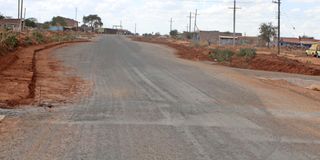Overloaded trucks crush the life out of rural roads

The 112km Kajiado-Imaroro-Mashuuru-Isara road whose construction is ongoing. The road is facing major destruction by transporters overloading lorries with sand.
What you need to know:
- New roads in areas where only gravel and earth sections existed, are also damaged by unexpected increase in traffic, which opens up for new residential houses.
- The government had particularly targeted rural roads with the 10,000 kilometres road plan that would see gravel and earth roads upgraded to bitumen using the LVSR which is faster and cheaper to execute.
- Apart from the Kenya National Highways Authority, KURA and KeRRA barely have weighbridges to monitor axle load controls on their roads meaning trucks carrying sand and stones have no checks until they hit highways.
- The continued damages now threaten to strain the Sh70 billion meant for road maintenance that motorists contribute at the fuel stations every year.
Authorities are struggling to secure newly constructed roads under the threat of overloaded trucks, which damage them even before their completion.
The menace especially on rural roads built using the low volume seal roads technology (LVSR ) has complicated maintenance plans for some agencies forced to start repairs as soon as sections of the new stretches are open to traffic.
New roads in areas where only gravel and earth sections existed, are also damaged by unexpected increase in traffic, which opens up for new residential houses.
“It is even more challenging for areas near urban centres where development waits until there is access and suddenly trucks ferrying construction materials begin using the road as people begin developing them. You can hardly stop them because they are just taking advantage of the access. It forces us sometimes to upgrade the roads which is an additional cost,” Kenya Urban Roads Authority Communication Director John Cheboi said.
Drivers carry excess capacity
The government had particularly targeted rural roads with the 10,000 kilometres road plan that would see gravel and earth roads upgraded to bitumen using the LVSR which is faster and cheaper to execute.
Rural roads under the Kenya Rural Roads Authority and the county governments continue to lag in upgrades with approximately 132,000 kilometers out of the total 136,794 kilometers still generally earth or gravel according to the authority.
Apart from the Kenya National Highways Authority, KURA and KeRRA barely have weighbridges to monitor axle load controls on their roads meaning trucks carrying sand and stones have no checks until they hit highways.
Materials are sourced from rural areas, exposing KeRRA roads to damage as some truck drivers now carry excess capacity and offload at certain points before joining highways. The offloaded bits are sold to other clients, creating a parallel construction material business.
The dilemma of whether to deny certain traffic categories access to these new roads and the failure to monitor axle loads on newly constructed roads threatens to derail the plan to use the new technology that was expected to open rural areas and decongest urban centres
Leading causes of road damage
KeRRA plans to spend Sh5.6 billion every year in road construction using LVSR until 2022 when it should have completed some 7000 kilometres.
“The Ngong-Kiserian and even the Ngong to Suswa road which is still under construction is already being repaired due to such damages.
“We find a lot of resistance from politicians when we try to enforce some of these restrictions,” an KeRRA engineer disclosed, asking not to be named as the matter is being addressed at higher levels.
Excess load is listed as one of the leading causes of road damage since every road is designed based on axle load calculated in equivalent-number, or known as equivalent axle load (EAL), measured in tonnes and projected over the service life of the road.
The continued damages now threaten to strain the Sh70 billion meant for road maintenance that motorists contribute at the fuel stations every year.





